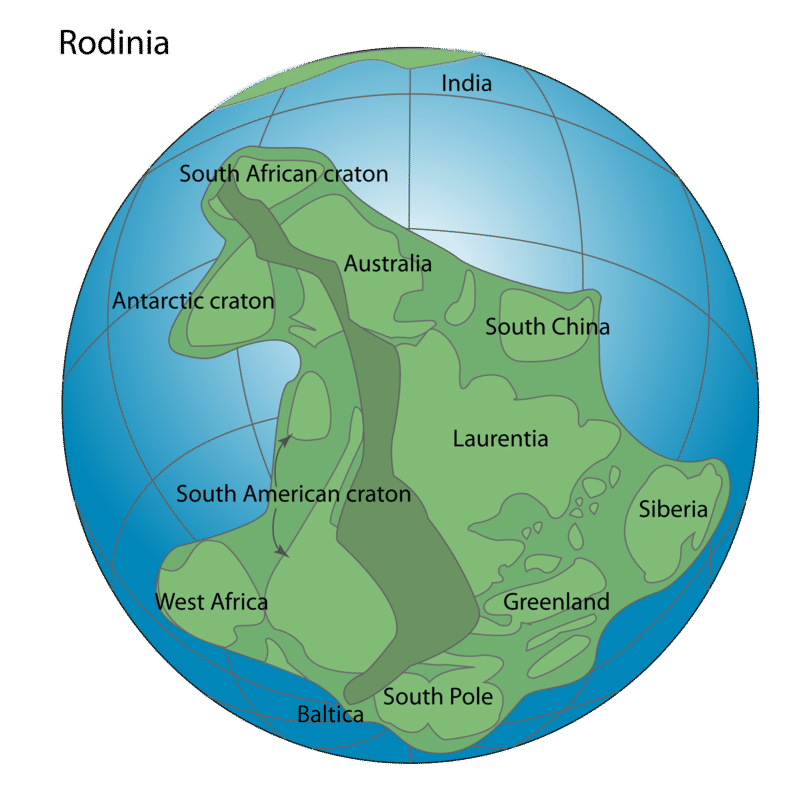READ: Plate Tectonics
READ: Plate Tectonics
Plate Tectonics Theory
The theory of plate tectonics is what brings together continental drift and seafloor spreading. Plates are made of lithosphere topped with oceanic and/or continental crust. The plates are moved around on Earth's surface by seafloor spreading. Convection in the mantle drives seafloor spreading. Oceanic crust is created at mid-ocean ridges. The crust moves outward from the ridge over time. The crust may eventually sink into the mantle and be destroyed. If a continent sits on a plate with a mid-ocean ridge, the continent will be pushed along.
Plate Boundaries
Two plates meet at a plate boundary. There are three types of plate boundaries since there are three ways that plates can meet. Plates can move away from each other. They can move toward each other. Finally, they can slide past each other. The three types of plate boundaries are divergent, convergent, and transform.
Most geological activity takes place at plate boundaries. This activity includes volcanoes, earthquakes, and mountain building. The activity occurs as plates interact. Giant slabs of lithosphere moving around can create a lot of activity! The features seen at a plate boundary are determined by the direction of plate motion and by the type of crust found at the boundary.
What The Theory Explains
The theory of plate tectonics explains most of the features of Earth’s surface. It explains why earthquakes, volcanoes and mountain ranges are where they are. It explains where to find some mineral resources. Plate tectonics is the key that unlocks many of the mysteries of our amazing planet. Plate tectonics theory explains why:
- Earth's geography has changed over time and continues to change today.
- some places are prone to earthquakes while others are not.
- certain regions may have deadly, mild, or no volcanic eruptions.
- mountain ranges are located where they are.
- many ore deposits are located where they are.
- living and fossil species of plants and animals are found where they are.
- some continental margins have a lot of geological activity, and some have none.
What is a Plate?
What portion of Earth makes up the “plates” in plate tectonics? Again, the answer came about in part due to war. In this case, the Cold War.
During the 1950s and early 1960s, scientists set up seismograph networks to see if enemy nations were testing atomic bombs. These seismographs also recorded all of the earthquakes around the planet. The seismic records were used to locate an earthquake’s epicenter, the point on Earth’s surface directly above the place where the earthquake occurs.
Why is this relevant? It turns out that earthquake epicenters outline the plates. This is because earthquakes occur everywhere plates come into contact with each other.
The lithosphere is divided into a dozen major and several minor plates. A single plate can be made of all oceanic lithosphere or all continental lithosphere, but nearly all plates are made of a combination of both.
The movement of the plates over Earth's surface is termed plate tectonics. Plates move at a rate of a few centimeters a year, about the same rate fingernails grow.
How Plates Move
If seafloor spreading drives the plates, what drives seafloor spreading?
This goes back to mantle convection. Picture two convection cells side by side in the mantle, similar to the illustration in the figure below.
- Hot mantle from the two adjacent cells rises at the ridge axis, creating new ocean crust.
- The top limb of the convection cell moves horizontally away from the ridge crest, as does the new seafloor.
- The outer limbs of the convection cells plunge down into the deeper mantle, dragging oceanic crust as well. This takes place at the deep sea trenches.
- The material sinks to the core and moves horizontally.
- The material heats up and reaches the zone where it rises again.
Plate Boundaries
Plate boundaries are the edges where two plates meet. How can two plates move relative to each other? Most geologic activities, including volcanoes, earthquakes, and mountain building, take place at plate boundaries. The features found at these plate boundaries are the mid-ocean ridges, trenches, and large transform faults (figure below).
- Divergent plate boundaries: the two plates move away from each other.
- Convergent plate boundaries: the two plates move towards each other.
- Transform plate boundaries: the two plates slip past each other.
The type of plate boundary and the type of crust found on each side of the boundary determines what sort of geologic activity will be found there. We can visit each of these types of plate boundaries on land or at sea.
Summary
- The plate in plate tectonics is a large chunk of lithosphere that can carry continental crust, oceanic crust, or some of each.
- Plates can be identified by the locations of earthquake epicenters. At the boundaries of plates are mid-ocean ridges, trenches, and large faults.
- Plates move by seafloor spreading, which is driven by mantle convection.
- Plates meet at plate boundaries. The three types are divergent, convergent, and transform.
- The theory of plate tectonics brings together continental drift and seafloor spreading.
- At a plate boundary, two plates can be moving apart, together or past each other.
- Plate tectonics theory explains many things in geology, such as where volcanoes, earthquakes, mountain ranges, ore deposits, and other features are located.



